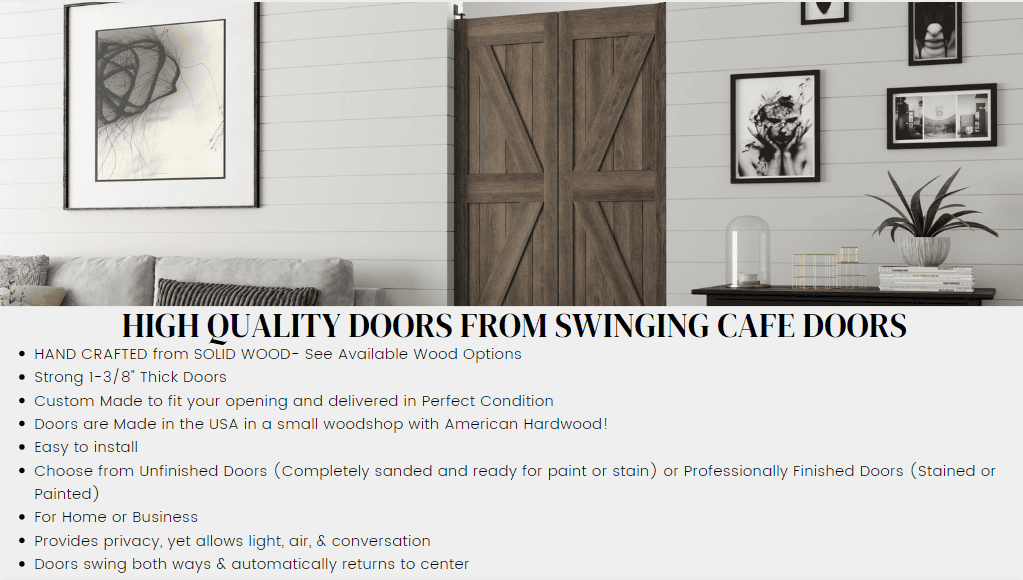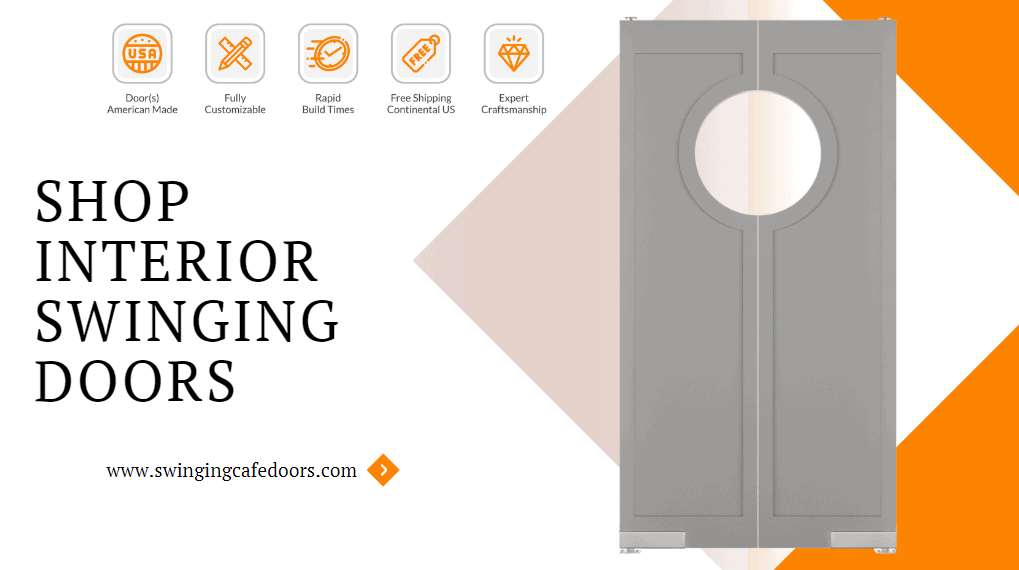
Top Materials for Premium Swinging Cafe Interior Doors
What Materials are Used to Manufacture High-Quality Interior Doors?
You've decided it's time for an interior door upgrade in your home. But with so many options out there, how do you choose a high-quality door that fits your style and budget? When selecting interior doors, the materials matter. Different materials provide different benefits, from solid wood for a luxurious traditional look to glass for an open, airy feel. For durability without the high cost of wood, composite or solid core doors are great alternatives. Before you start shopping, learn about the most common materials used in high-quality interior doors so you can choose what's right for your space.
Solid Wood: The Classic Material for Interior Doors
When it comes to interior doors, solid wood is the gold standard for quality and beauty.
Wood doors offer a timeless, natural look that adds warmth to any space. The most common types of wood for interior doors are oak, maple, cherry, and pine. Oak and maple provide a dense, durable door that can last for generations. Cherry wood has a rich, reddish tone that darkens over time. Pine is a more affordable, lightweight option with a rustic feel.
With wood doors, you'll enjoy details like wood grain patterns, knots, and color variation that make each door unique. Wood doors also provide superior noise control and security compared to hollow core or glass doors. However, wood doors typically cost more and may require occasional refinishing to maintain their appearance.
If the price tag of solid wood is out of your budget, consider a wood veneer door. These doors have a thin wood laminate layer, so they provide a similar visual style at a lower cost. They won't last as long or offer the same soundproofing as solid wood, but can still give you the warm, high-quality look you want without the premium price.
For a touch of luxury, you can't go wrong with solid wood interior doors. Whether you prefer the rustic charm of pine, the refined elegance of cherry, or the timeless style of oak, wood doors make a statement and turn your house into a home. With the right care and maintenance, they'll provide decades of beauty and performance.
Engineered Wood: Affordable Stability Through Rail and Stile Joinery
When it comes to interior doors, engineered wood is an affordable yet attractive option. Engineered wood doors are made from wood veneers and composite materials for stability, giving you the beautiful look of real wood at a lower cost.
Rail and Stile Joinery for Strength
The rails and stiles - the vertical and horizontal pieces that make up the door frame - are joined together for maximum strength and durability. The center panel is typically made of a composite material or wood veneer. This construction prevents the door from warping, cracking, or bowing, even in humid weather.
Engineered wood doors can replicate the style of solid wood doors with wood grains and stains to match your home's decor. They provide good soundproofing and insulation for bedrooms,
bathrooms and home offices. Popular and budget-friendly choices include oak, maple, mahogany, or walnut.
When properly installed and maintained, engineered wood doors can last for decades. They do require occasional sealing or re-staining to protect the wood veneer from moisture damage or fading. But with their strength, style, and affordability, engineered wood doors are a wonderful alternative if you want the luxury of wood without the high cost or maintenance. For quality, beauty, and value, engineered wood doors are a perfect choice for your home.
Fiberglass: A Low-Maintenance Interior Door Material
Fiberglass is a popular, low-maintenance material for interior doors. Fiberglass doors are made from a fiber-reinforced plastic composite that provides an attractive wood-grain look without the maintenance hassles of real wood.
Fiberglass doors won't warp, crack, or split like wood doors can. They hold their shape well over time and in varying weather conditions. Fiberglass doors are also resistant to scratches, dents, and stains. You'll never have to paint or refinish a fiberglass door to keep it looking new. An occasional wipe down with a damp cloth is all the cleaning needed.
Fiberglass interior doors are available in a range of styles from simple slab doors to high-end custom designs with glass panels, carvings, or decorative hardware. The fiberglass material readily accepts wood stains and paints, so fiberglass doors can match any decor.
Fiberglass doors provide good soundproofing and insulation for your home. The dense, solid core prevents noise and temperature transfer between rooms. Fiberglass doors also offer enhanced security compared to hollow-core wood or metal doors.
While fiberglass doors are more expensive than hollow core doors upfront, their durability and longevity make them a good investment. A high-quality fiberglass door should last a lifetime with minimal signs of wear or weathering.
If you're looking for attractive yet virtually maintenance-free interior doors, fiberglass doors are an excellent choice. Their wood-like look, durability, and performance make fiberglass a premier material for interior doors in high-end homes. Once installed, you can enjoy the beauty of fiberglass doors without the hassle.
Steel: Durability and Security in Interior Doors
Steel doors are a popular choice for interior doors because they offer unparalleled durability and security. Steel doors are made of galvanized steel sheets that have been stamped, cut, and folded into door shapes. The steel is then usually painted or powder-coated for an attractive finish.
Strength and Protection
Steel doors are the strongest type of interior door and are ideal for high-traffic areas or where extra security is needed. Their dense, heavy-duty construction makes them resistant to dents, scratches, and damage. Steel doors also provide excellent soundproofing and insulation. If you're looking to prevent noise transfer between rooms or increase the energy efficiency of your home, steel doors are a great option.
Low Maintenance
Steel doors require very little maintenance to keep looking their best. They won't warp, crack, or split over time like wood doors. Steel doors also won't fade or discolor when exposed to humidity or sunlight. An occasional wipe down with a damp cloth is all that's needed to clean most steel doors. For stubborn stains or marks, a mild detergent can be used. Steel doors with a painted or powder-coated finish may need to be repainted after many years of use to restore their appearance.
Affordability
While steel doors are more expensive than hollow core doors, they are typically more affordable than solid wood doors. Their durability also means lower long-term costs since steel doors rarely need repairs or replacement. For budget-friendly interior doors that provide real substance, steel doors strike an ideal balance of performance, quality, and price.
Steel doors offer an attractive combination of strength, security, low maintenance, and affordability. For interior doors that need to stand up to high traffic or rough use, steel is an excellent choice that will last for decades. With styles ranging from sleek and modern to traditional, there's a steel door to complement any home's decor.
Glass: Let the Light Shine in With Interior Glass Doors
Glass doors are a popular choice for interior doors because they allow natural light to filter through while still providing privacy. If you want doors that make a statement, glass is the way to go.
Let the Light Shine In
Glass doors are perfect for spaces where you want to allow light to pass through, such as dens, home offices, or bedrooms. They give the space an open, airy feel while still closing it off when privacy is needed. Glass doors with frosted or patterned glass diffuse the light, preventing a harsh glare while still brightening the room.
For extra style, consider doors with decorative glass inserts, etching, or beveling. The glass can be sandblasted, acid-etched, or laser-etched with everything from simple lines and dots to intricate floral or nature-inspired designs. Beveled or leaded glass with multiple small panes gives doors an elegant, custom look.
Doors with glass panels, especially those with decorative inserts, make a bold decorative statement. They instantly elevate the style of the room and your home. The glass allows you to see into the next room, creating an open flow between spaces. At the same time, the door provides sound insulation and privacy when closed.
Glass interior doors do tend to be on the higher end, cost-wise. However, their style, light-transmitting ability, and sound-dampening qualities make them worth the investment for certain spaces in your home. When you want a door that is as much a design feature as it is functional, glass doors shine through.
So now that you have the lowdown on what materials are used to make high-quality interior doors, you can make a well-informed choice for your home. Whether you want the warmth and richness of wood, the elegance and style of glass, the practicality and affordability of solid or hollow core, or a combination, you have options. Take your time evaluating what matters most for each room - noise control, energy efficiency, budget, or pure aesthetics. The doors you choose say a lot about your home and personal style. Make them count!


